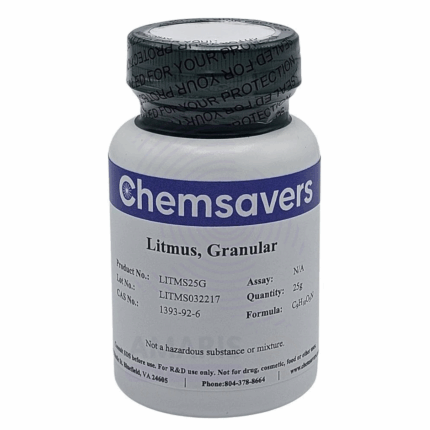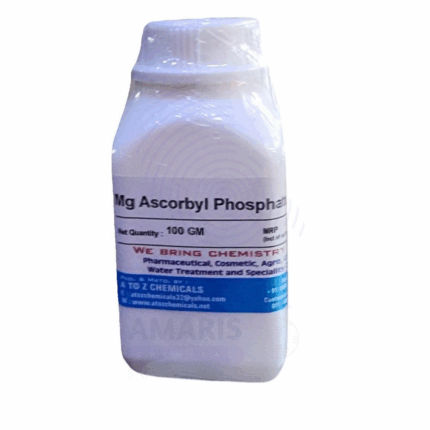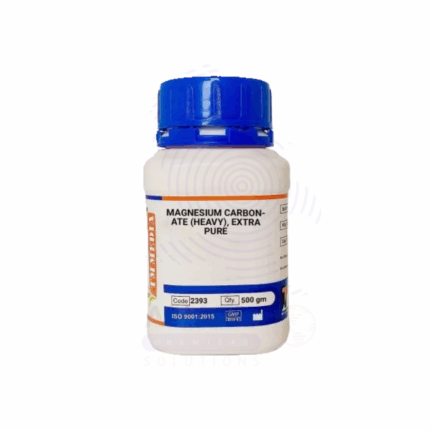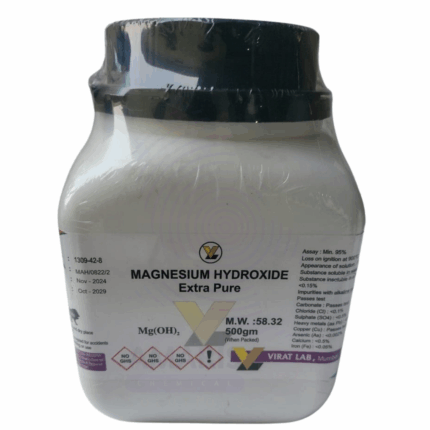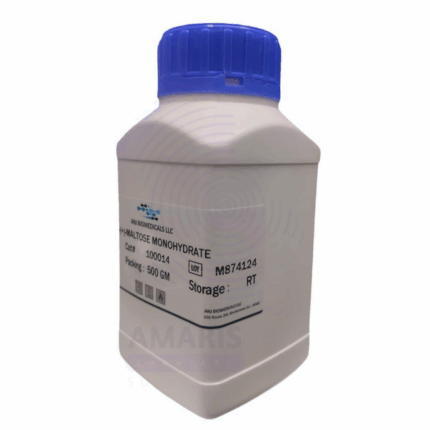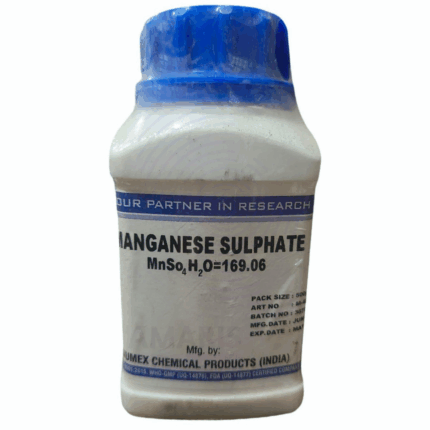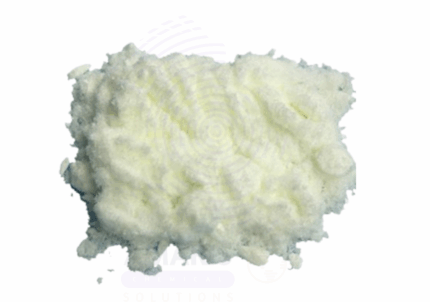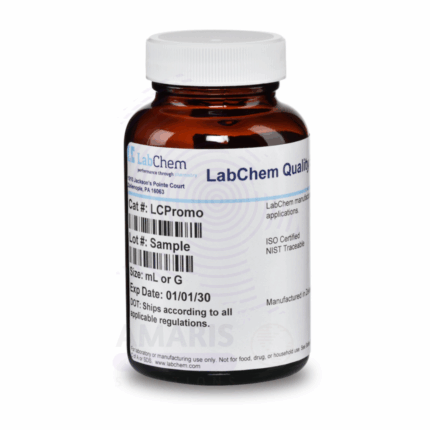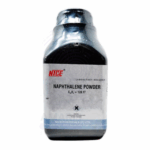
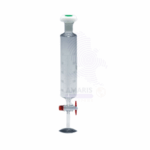
Neutral Red Solution Extra Pure
$ 176.85 Original price was: $ 176.85.$ 16.78Current price is: $ 16.78.
Neutral Red Solution Extra Pure is a high-purity, ready-to-use solution of the pH indicator dye Neutral Red, widely employed in biological, biochemical, and analytical laboratories. Known for its distinct color change—red in acidic environments and yellow in alkaline—it is commonly used to stain lysosomes in viable cells, making it invaluable in cell viability assays, cytotoxicity studies, and microscopic cell structure investigations.
This Extra Pure grade ensures excellent clarity and precision in results, especially in sensitive microbiological and histological procedures. It is frequently used in conjunction with culture media to observe metabolic activities and in vital staining techniques to differentiate between live and dead cells. Proper handling involves storing it in tightly sealed amber containers away from light and heat to maintain its stability and effectiveness.
Neutral Red Solution Extra Pure
Primary Uses
- Vital Stain in Cell Biology and Microbiology
- Used as a vital stain to distinguish between living and dead cells in cultures. Living cells actively take up the dye and accumulate it in lysosomes, appearing red, while dead cells do not sequester the stain effectively. It is also used to visualize phagocytosis and lysosomal activity.
- pH Indicator in Biochemical and Microbiological Media
- Functions as a pH indicator, changing color from red (at pH 6.8 and below) to yellow (at pH 8.0 and above). This property is utilized in culture media to indicate acid production by microorganisms, such as in the Neutral Red Broth test for differentiating enteric bacteria.
- Endpoint Indicator in Titration Analysis
- Employed as a visual endpoint indicator in acid-base titrations within its specific pH transition range. Its clear color change is useful in analytical chemistry procedures where a sharp visual cue is needed for neutralization points in slightly acidic to basic transitions.
- Assay Reagent for Cytotoxicity and Cell Viability
- Used in the Neutral Red Uptake (NRU) assay, a standard in vitromethod to assess cell viability and cytotoxicity. The amount of dye incorporated by healthy, viable cells is quantified spectrophotometrically, providing a measure of the toxic effects of chemicals or environmental samples.
Secondary Uses
- Stain for Histological and Microscopic Observation
- Used as a supravital stain for temporary staining of blood samples and other tissues to highlight specific cellular structures, such as granules or organelles, under a light microscope for educational or preliminary diagnostic purposes.
- Marker in Soil Science and Ecotoxicology Studies
- Applied in soil science experiments to stain and visualize microbial colonies directly on soil particles. It is also used as a bioindicator in ecotoxicology to assess the health of invertebrate or microbial communities exposed to pollutants.
- Photosensitizer in Photodynamic Studies
- Investigated for use in photodynamic therapy (PDT) research and related studies. When taken up by cells and exposed to specific light wavelengths, Neutral Red can generate reactive oxygen species, leading to targeted cell death in experimental models.
- Teaching Tool for Membrane Permeability and Transport
- An ideal reagent for classroom demonstrations and student laboratories to study concepts of membrane permeability, active transport (as its uptake is energy-dependent), and lysosomal function in eukaryotic cells.
| PACK SIZE |
100ml |
|---|
1. Basic Identification Attributes
- Chemical Name: Neutral Red (solution)
- CAS Number: 553-24-2 (for Neutral Red dye)
- HS Code: 3204.12.00
- Molecular Formula: C₁₅H₁₇ClN₄ (for Neutral Red dye)
- Synonyms: Toluylene Red, Basic Red 5, C.I. 50040, Neutral Red Stain
2. Physical & Chemical Properties
- Physical State: Liquid solution
- Color & Odor: Red to reddish-purple solution; mild odor
- Boiling Point: Depends on solvent (typically water/alcohol base ~100 °C)
- Melting Point: Not applicable (solution)
- Density: ~1.0–1.1 g/cm³ (depending on concentration and solvent)
- Solubility: Fully miscible in water and alcohol
- pH Level: ~6.8–8.0 (depending on concentration)
- Vapor Pressure: Low (water-based)
- Flash Point: Non-flammable (if aqueous solution)
- Autoignition Temperature: Not applicable
- Viscosity: Similar to water unless thickened
3. Safety & Hazard Attributes
- Hazard Class (GHS):
- Eye Irritation (Category 2B)
- Skin Irritation (Category 2, depending on concentration)
- Not classified as flammable or acutely toxic in dilute form
- NFPA Ratings:
- Health: 1
- Flammability: 0
- Reactivity: 0
- Exposure Limits: Not established for dilute solutions; treat as low-hazard dye
- Reactivity: Stable under normal conditions; avoid oxidizers and strong acids/bases
4. Storage & Handling Attributes
- Storage Conditions: Store in tightly sealed bottle, away from light and heat
- Incompatible Materials: Strong oxidizers, acids, bases
- Container Type: Amber glass or plastic bottle
- Shelf Life & Expiration Date: ~2 years under proper storage
- Special Handling Requirements: Use gloves and lab coat; avoid skin and eye contact
5. Regulatory & Compliance Attributes
- Regulatory Status:
- Not classified as hazardous under many global regulations in dilute form
- Use and disposal may be regulated in lab or clinical environments
- Transportation Restrictions: Not classified as hazardous for transport if aqueous and dilute
- Waste Disposal Method: Dispose via drain with excess water (small amounts), or according to local lab disposal procedures
6. Environmental & Health Impact
- Ecotoxicity: Low in dilute form; avoid direct discharge into waterways
- Persistence in Environment: Dye may persist in soil or water in higher concentrations
- Carcinogenicity/Mutagenicity:
- Not classified as carcinogen in dilute solution
- No strong evidence of mutagenicity at low concentrations
Biodegradability: Moderate; breakdown depends on environmental conditions
SAFETY PRECAUTIONS
Personal Protective Equipment (PPE):
- Wear a lab coat, nitrile or latex gloves, and protective safety goggles.
- Use a fume hood or ensure adequate ventilation during handling.
Handling:
- Avoid contact with eyes, skin, and clothing.
- Do not breathe vapors or mist.
- Use only in well-ventilated areas.
- Wash hands thoroughly after handling.
Storage:
- Store in a tightly closed container in a cool, dry, and well-ventilated location.
- Protect from light, heat, and incompatible substances such as strong oxidizers and acids.
FIRST AID MEASURES
Inhalation:
- Move the exposed person to fresh air.
- Keep at rest and seek medical attention if respiratory symptoms persist.
Skin Contact:
- Wash affected areas with soap and plenty of water.
- Remove contaminated clothing and seek medical advice if irritation develops.
Eye Contact:
- Rinse cautiously with water for several minutes.
- Remove contact lenses if present and easy to do.
- Continue rinsing and seek medical attention if irritation persists.
Ingestion:
- Rinse your mouth thoroughly with water.
- Do not induce vomiting.
- Seek medical attention immediately.
FIRE FIGHTING MEASURES
Flammability:
- Not classified as highly flammable, but components may be combustible.
Extinguishing Media:
- Use water spray, dry chemical, carbon dioxide (CO₂), or alcohol-resistant foam.
Hazardous Combustion Products:
- May emit toxic fumes such as carbon oxides and nitrogen oxides upon thermal decomposition.
Firefighter Protection:
- Firefighters should wear self-contained breathing apparatus (SCBA) and full protective clothing.
Avoid inhalation of combustion vapors.


 Preservatives(food)
Preservatives(food) Flavor Enhancers
Flavor Enhancers Acidulants
Acidulants Sweeteners
Sweeteners Antioxidants
Antioxidants Colorants(food)
Colorants(food) Nutraceutical Ingredients (food)
Nutraceutical Ingredients (food) Nutrient Supplements
Nutrient Supplements Emulsifiers
Emulsifiers
 Collectors
Collectors Dust Suppressants
Dust Suppressants Explosives and Blasting Agents
Explosives and Blasting Agents Flocculants and Coagulants
Flocculants and Coagulants Frothers
Frothers Leaching Agents
Leaching Agents pH Modifiers
pH Modifiers Precious Metal Extraction Agents
Precious Metal Extraction Agents
 Antioxidants(plastic)
Antioxidants(plastic) Colorants (Pigments, Dyes)
Colorants (Pigments, Dyes) Fillers and Reinforcements
Fillers and Reinforcements Flame Retardants
Flame Retardants Monomers
Monomers Plasticizers
Plasticizers Polymerization Initiators
Polymerization Initiators Stabilizers (UV, Heat)
Stabilizers (UV, Heat)
 Antifoaming Agents
Antifoaming Agents Chelating Agents
Chelating Agents Coagulants and Flocculants
Coagulants and Flocculants Corrosion Inhibitors
Corrosion Inhibitors Disinfectants and Biocides
Disinfectants and Biocides Oxidizing Agents
Oxidizing Agents pH Adjusters
pH Adjusters Scale Inhibitors( water)
Scale Inhibitors( water)
 Antioxidants(cosmetic)
Antioxidants(cosmetic) Emollients
Emollients Fragrances and Essential Oils
Fragrances and Essential Oils Humectants
Humectants Preservatives
Preservatives Surfactants(cosmetic)
Surfactants(cosmetic) Thickeners
Thickeners UV Filters
UV Filters
 Fertilizers
Fertilizers Soil Conditioners
Soil Conditioners Plant Growth Regulators
Plant Growth Regulators Animal Feed Additives
Animal Feed Additives Biostimulants
Biostimulants Pesticides (Herbicides, Insecticides, Fungicides)
Pesticides (Herbicides, Insecticides, Fungicides)
 Active Pharmaceutical Ingredients (APIs)
Active Pharmaceutical Ingredients (APIs) Excipients
Excipients Solvents(pharmaceutical)
Solvents(pharmaceutical) Antibiotics
Antibiotics Antiseptics and Disinfectants
Antiseptics and Disinfectants Vaccine Adjuvants
Vaccine Adjuvants Nutraceutical Ingredients (pharmaceutical)
Nutraceutical Ingredients (pharmaceutical) Analgesics & Antipyretics
Analgesics & Antipyretics
 Analytical Reagents
Analytical Reagents Solvents(lab)
Solvents(lab) Chromatography Chemicals
Chromatography Chemicals Spectroscopy Reagents
Spectroscopy Reagents microbiology-and-cell-culture-reagents
microbiology-and-cell-culture-reagents Molecular Biology Reagents
Molecular Biology Reagents Biochemical Reagents
Biochemical Reagents Inorganic and Organic Standards
Inorganic and Organic Standards Laboratory Safety Chemicals
Laboratory Safety Chemicals Specialty Laboratory Chemicals(Special Laboratory Equipment)
Specialty Laboratory Chemicals(Special Laboratory Equipment)
 Demulsifiers
Demulsifiers Hydraulic Fracturing Fluids
Hydraulic Fracturing Fluids Scale Inhibitors(oil)
Scale Inhibitors(oil) Surfactants(oil)
Surfactants(oil) Drilling Fluids
Drilling Fluids
 Dyes and Pigments
Dyes and Pigments Bleaching Agents
Bleaching Agents Softening Agents
Softening Agents Finishing Agents
Finishing Agents Antistatic Agents
Antistatic Agents
 Admixtures
Admixtures Waterproofing Agents
Waterproofing Agents Sealants and Adhesives
Sealants and Adhesives Curing Compounds
Curing Compounds Concrete Repair Chemicals
Concrete Repair Chemicals Anti-Corrosion Coatings
Anti-Corrosion Coatings
 Surfactants(cleaning)
Surfactants(cleaning) Builders
Builders Enzymes
Enzymes Solvents (Cleaning)
Solvents (Cleaning) Fragrances
Fragrances
 Electronic Chemicals
Electronic Chemicals Catalysts
Catalysts Lubricants
Lubricants Photographic Chemicals
Photographic Chemicals Refrigerants
Refrigerants Automotive chemicals
Automotive chemicals Pyrotechnic Chemicals
Pyrotechnic Chemicals
 Biodegradable Surfactants
Biodegradable Surfactants Bio-based Solvents
Bio-based Solvents Renewable Polymers
Renewable Polymers Carbon Capture Chemicals
Carbon Capture Chemicals Wastewater Treatment Chemicals
Wastewater Treatment Chemicals
 Pigments
Pigments Solvents(paint)
Solvents(paint) Specialty Coatings
Specialty Coatings Binders/Resins
Binders/Resins Additives
Additives Driers
Driers Anti-Corrosion Agents
Anti-Corrosion Agents Functional Coatings
Functional Coatings Application-Specific Coatings
Application-Specific Coatings
 Fresh Herbs
Fresh Herbs Ground Spices
Ground Spices Whole Spices
Whole Spices Spice Blends
Spice Blends Dried Herbs
Dried Herbs
 Leavening Agents
Leavening Agents Dough Conditioners
Dough Conditioners Flour Treatments
Flour Treatments Fat Replacers
Fat Replacers Decoratives
Decoratives Preservatives(baking)
Preservatives(baking)
 Plasticizers & Softeners
Plasticizers & Softeners Reinforcing Agents
Reinforcing Agents Adhesion Promoters
Adhesion Promoters Vulcanizing Agents
Vulcanizing Agents Antidegradants
Antidegradants Blowing Agents
Blowing Agents Fillers & Extenders
Fillers & Extenders Accelerators & Retarders
Accelerators & Retarders

